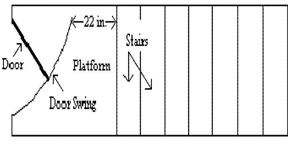PDFWAC 296-24-74005
General requirements for all stairs.
In addition to the requirements in WAC 296-24-735, you must ensure:
(1) Handrails, stair rail systems, and guardrail systems are provided in accordance with WAC 296-24-74015.
Note: | For guardrail system requirements, see the unified fall protection rule (chapter 296-880 WAC). |
(2) Vertical clearance above any stair tread to any overhead obstruction is at least 6 feet 8 inches (203 cm), as measured from the leading edge of the tread. Spiral stairs must meet the vertical clearance requirements in WAC 296-24-74015.
(3) Stairs have uniform riser heights and tread depths between landings.
(4) Stairway landings and stair platforms are at least the width of the stair and at least 30 inches (76 cm) in depth; as measured in the direction of travel.
(5) When a door or a gate opens directly on a stairway, a stair platform is provided, and the swing of the door or gate does not reduce the stair platform's effective usable depth to:
(a) Less than 20 inches (51 cm) for stair platforms installed before October 1, 2020; and
(b) Less than 22 inches (56 cm) for stair platforms installed on or after October 1, 2020 (see Figure D-7 of this section).
(6) Each stair can support at least five times the normal anticipated live load, but never less than a concentrated load of 1,000 pounds (454 kg) applied at any point.
(7) Standard stairs are used to provide access from one walking-working surface to another when operations necessitate regular and routine (once per week) travel between levels, including access to operating platforms for equipment. Winding stairways may be used on tanks and similar round structures when the diameter of the tank or structure is at least 5 feet (1.5 m).
(8) Spiral, ship, or alternating tread-type stairs are used only when the employer can demonstrate that it is not feasible to provide standard stairs.
(9) When subsection (8) of this section allows the use of spiral, ship, or alternating tread-type stairs, they are installed, used, and maintained in accordance with manufacturer's instructions.
 |
Figure D-7 - Door or Gate Opening on Stairway
(10) Each tread and the top landing of a stairway, where risers are used, should have a nose which extends .5 inch to 1 inch beyond the face of the lower riser.
(11) Stair tread noses should have an even leading edge.